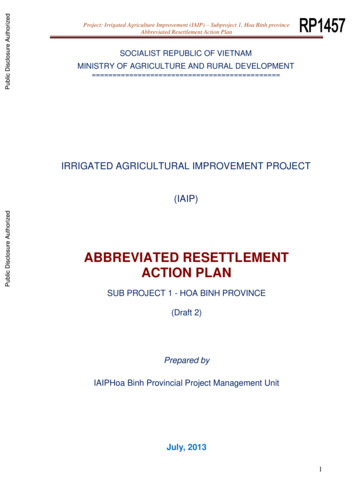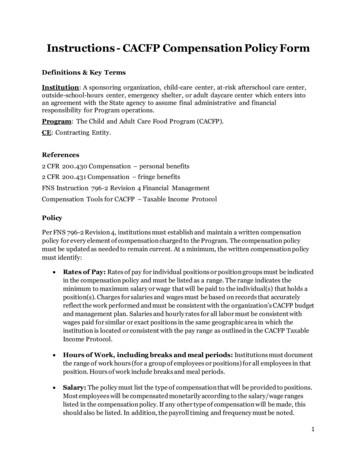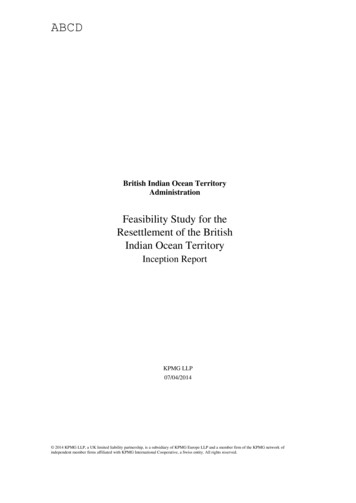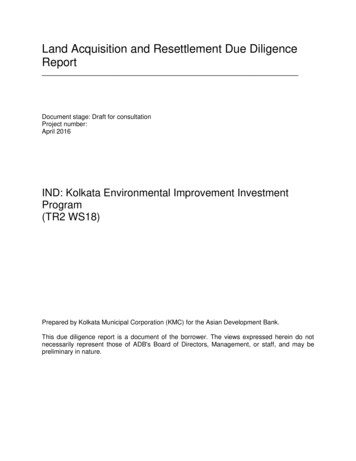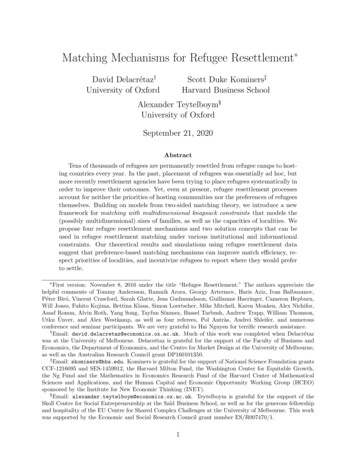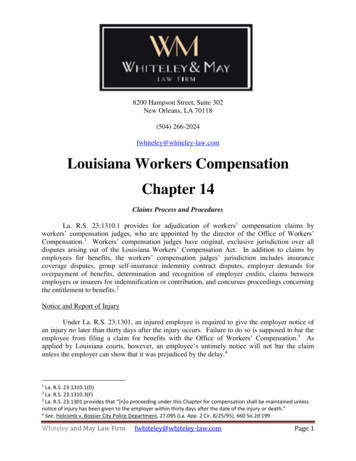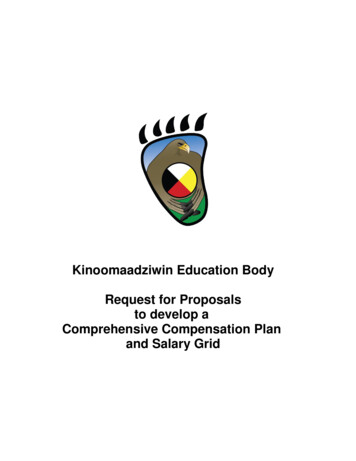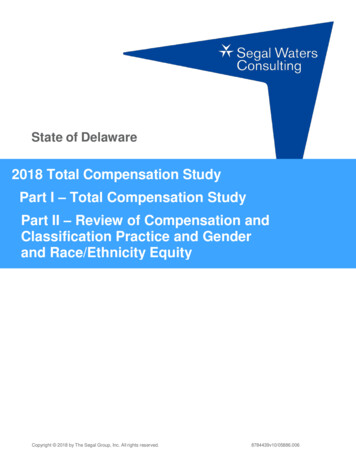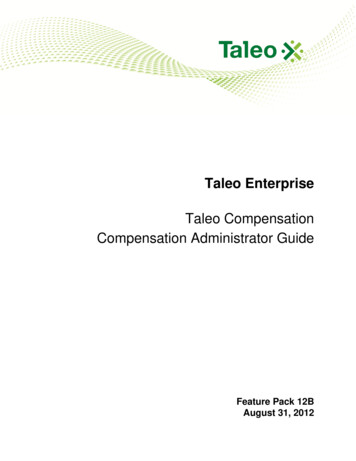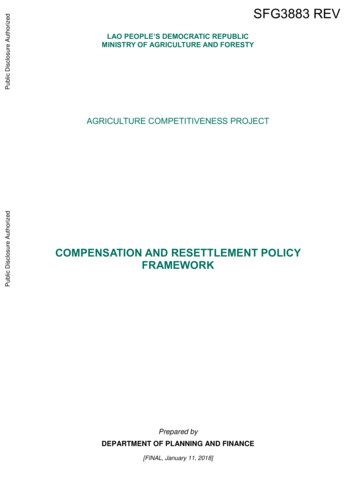
Transcription
Public Disclosure AuthorizedPublic Disclosure AuthorizedLAO PEOPLE’S DEMOCRATIC REPUBLICMINISTRY OF AGRICULTURE AND FORESTYAGRICULTURE COMPETITIVENESS PROJECTCOMPENSATION AND RESETTLEMENT POLICYFRAMEWORKPublic Disclosure AuthorizedPublic Disclosure AuthorizedSFG3883 REVPrepared byDEPARTMENT OF PLANNING AND FINANCE[FINAL, January 11, 2018]
TABLE OF CONTENTSTABLE OF CONTENTS . ILIST OF ACRONYMS . IVTERMS AND DEFINITIONS . VACKNOWLEDGEMENTS. VII1.0INTRODUCTION. 11.1PROJECT OVERVIEW . 11.2PROJECT IMPACTS . 31.3APPLICABLE WORLD BANK SAFEGUARDS POLICIES . 31.4RATIONALE FOR CRPF PREPARATION . 42.0OBJECTIVE, APPROACH AND PRINCIPLES GOVERNING RESETTLEMENT . 43.0RESETTLEMENT PROCESS AND APPROVAL . 54.0CATEGORIES OF DISPLACED PERSONS . 75.0DISPLACED PERSONS ELIGIBILITY CRITERIA . 86.0LEGAL FRAMEWORK ASSESSMENT . 97.0ASSET VALUATION .168.0ORGANIZATIONAL PROCEDURES FOR ENTITLEMENTS.189.0LINKING RESETTLEMENT TO CIVIL WORKS .2410.0GRIEVANCE REDRESS MECHANISM .2411.0ARRANGEMENTS FOR FUNDING RESETTLEMENT .2712.0INFORMATION DISCLOSURE, PUBLIC CONSULTATIONS, AND PARTICIPATION .2712.1 OBJECTIVE OF INFORMATION DISCLOSURE, PUBLIC CONSULTATION ANDPARTICIPATION .2712.2 MECHANISM FOR INFORMATION DISCLOSURE, PUBLIC CONSULTATION ANDPARTICIPATION .2812.3 CONSULTATION APPROACH ADOPTED FOR PREPARING THIS CRPF .2813.0MONITORING AND EVALUATION .3013.1 INTERNAL MONITORING .3113.2 EXTERNAL MONITORING .3214.0VOLUNTARY LAND DONATION (ANNEX) FRAMEWORK .3215.0COSTS AND BUDGET .34ANNEXES . 1ANNEX 1A - SOCIAL SCREENING FORM .41i
ANNEX 1B - ABBREVIATED RESETTLEMENT ACTION PLAN (ARAP): ANNOTATEDDOCUMENT CONTENTS AND INFORMATION REQUIREMENTS .45ANNEX 2A - PROCESS OF LAND DONATION .52ANNEX 2B - VOLUNTARY LAND DONATION FORM .56ANNEX 3 – SUGGESTIVE GENDER ACTION & MONITORING PLAN FOR RAP .57ANNEX 4: RESULTS OF THE PUBLIC CONSULTATION ON DECEMBER 6, 2017 .59ii
LIST OF TABLESTable 1Table 2Gap analysis between the World Bank Involuntary Resettlement Policy (OP/BP 4.12)and Lao PDR 2016 Decree # 84 on Compensation and Resettlement of PeopleAffected by Development Projects. .12Entitlement matrix. .19Figure 1GRM process. .26LIST OF FIGURESiii
LIST OF ACRONYMSARAPAbbreviated Resettlement Action PlanCBOCommunity Based OrganizationsCRPFCompensation and Resettlement Policy FrameworkCSOCivil Society OrganizationsDAFODistrict Agriculture and Forestry OfficeDOPFDepartment of Planning, Cooperation and FinanceDOPFDesignated Implementing AgencyEGDPEthnic Group Development PlanEGEFEthnic Groups Engagement FrameworkEPLEnvironmental Protection LawESIAEnvironmental and Social Impact AssessmentESMFEnvironmental and Social Management FrameworkESMPEnvironmental and Social Management PlanFGDFocus Group DiscussionGoLGovernment of Lao PDRGRIGrievance RedressICTInformation and Communications TechnologyIDAInternational Development AssociationLRSP-2Lao Road Sector Project 2MAFMinistry of Agriculture and ForestryM&EMonitoring and EvaluationMOFMinistry of FinanceMONREMinistry of Natural Resources and EnvironmentMoICTMinistry of Information, Communication and TourismMPIMinistry of Planning and InvestmentNPANon-Profit AssociationsOP/BPWorld Bank Operational PoliciesPAFOProvincial Agriculture and Forestry OfficePAHProject Affected HouseholdsPAPProject Affected PeoplePONREProvincial Office of Natural Resources and EnvironmentPDRPDOPeople's Democratic PublicProject Development ObjectivePPTProject Preparation TeamRAPResettlement Action PlanRoIRegion of InfluenceSDSSocial Development SpecialistSIASocial Impact AssessmentToRTerms of ReferenceVRSVillage Resettlement Sub-committeesWBWorld Bankiv
TERMS AND DEFINITIONSBeneficiary – all persons and households from the villages who voluntarily seek to avail of and be partof the project.Compensation – payment in cash or in kind of the replacement cost of the acquired assets for theproject.Cut-off Date – the date prior to which the occupation or use of the project area makes residents/usersof the project area eligible to be categorized as affected persons. The cut-off date is established in theResettlement Action Plan (RAP). It normally coincides with the date of the census of affected personswithin the project area boundaries, or the date of public notification regarding the specific civil worksthat would cause displacement. Persons not covered in the census, because they were not residing,having assets, or deriving an income from the project area, are not eligible for compensation and otherentitlements.Displaced persons – refers to all of the people who, on account of the activities listed above, wouldhave their (1) standard of living adversely affected; or (2) right, title, interest in any house, land (includingpremises, agricultural and grazing land) or any other fixed or movable asset acquired or possessedtemporarily or permanently; (3) access to productive assets adversely affected, temporarily orpermanently; or (4) business, occupation, work or place of residence or habitat adversely affected; and“displaced person” means any of the displaced persons, including those who have no legal recognizableright or claim to the land they are occupying.Eligible land holders – refers to affected persons who (a) hold title to land; or (b) do not hold title butwhose possession of land can be legalized with a title pursuant to the Land Law of Lao People’sDemocratic Republic (PDR). Also eligible are those persons and households who have no legalrecognizable right or claim to the land they are occupying, but who are nonetheless entitled toassistance to restore their living standards, livelihoods, and any land-affixed assets affected.Entitlement – range of measures comprising compensation, income restoration support, transferassistance, income restoration, and relocation support which are due to affected people, depending onthe nature of their losses, to restore their economic and social base.Household – means all persons living and eating together as a single social unit.Income restoration – means re-establishing income sources and livelihoods of Project AffectedHouseholds (PAH) to a minimum of the pre-project level.Improvements – structures constructed (dwelling unit, fence, waiting sheds, pig pens, utilities,community facilities, stores, warehouses, etc.) and crops/plants planted by the person, household,institution, or organization.Land acquisition – the process whereby a person involuntary loses ownership, use of, or access to,land as a result of the project. Land acquisition can lead to a range of associated impacts, includingloss of residence or other fixed assets (fences, wells, tombs, or other structures or improvements thatare attached to the land).Project Authorities – refers to the Ministry of Agriculture and Forestry, the Ministry of Planning andInvestment (MPI), Ministry of Finance (MOF) and Ministry of Natural Resources and Environment(MONRE).Project Affected Persons (PAP) or Households (PAH) – includes any person, households, entity,organizations, firms or private institutions who, on account of changes that result from the project willhave their (i) standard of living adversely affected; (ii) right, title, or interest in any house, land (includingresidential, commercial, agricultural, forest, plantations, grazing, and/organizing land), water resources,fish ponds, communal fishing grounds, annual or perennial crops and trees, or any other moveable orfixed assets acquired, possessed, restricted, or otherwise adversely affected, in full or in part,permanently or temporarily; and/or (iii) business, occupation, place of work or residence, or habitatadversely affected, permanently or temporarily, with or without displacement.Rehabilitation – refers to assistance provided to persons seriously affected due to the loss ofproductive assets, incomes, employment or sources of living, to supplement payment of compensationfor acquired assets, in order to achieve, at a minimum, full restoration of living standards and quality oflife. Compensation for assets may not be sufficient to achieve full rehabilitation.v
Replacement cost – is the method of valuation of assets which determines the amount ofcompensation sufficient to replace lost assets, including any necessary transaction costs.Compensation at replacement cost is defined as follows: For agricultural land, it is the pre-sub-projector pre-displacement, whichever is higher, market value of land of equal productive potential or uselocated in the vicinity of the affected land, plus the cost of preparing the land to levels similar to thoseof the affected land, plus the cost of any registration and transfer taxes. For land in urban areas, it isthe pre-displacement market value of land of equal size and use, with similar or improved publicinfrastructure facilities and services and located in vicinity of the affected land, plus the cost of anyregistration and transfer taxes. For houses and other structures, it is the market cost of the materials tobuild a replacement structure with an area and quality similar to or better than those of the affectedstructure, or to repair a partially affected structure, plus the cost of transporting building materials to theconstruction site, plus the cost of any labor and contractors' fees, plus the cost of any registration andtransfer taxes. In determining the replacement cost, depreciation of the asset and the value of salvagematerials are not taken into account, nor is the value of benefits to be derived from the project deductedfrom the valuation of an affected asset. Where domestic law does not meet the standard ofcompensation at full replacement cost, compensation under domestic law is supplemented by additionalmeasures so as to meet the replacement cost standard. Such additional assistance is distinct fromresettlement measures to be provided under other clauses in World Bank Operational Policies (OP/BP)4.12, Para. 6.Replacement Cost Study (RCS) - The main objective of the RCS is to determine the rate of land pricesbased on actual transaction records of the affected areas, of affected main and secondary1 structures andother immovable assets. This study would be conducted by an independent appraiser. Based on theresults of RCS, the PAH will receive compensation at replacement cost (reflecting market price) from fortheir loss of land and property due to the sub-project. The RCS will be implemented during the impactassessment.Resettlement – means that all measures should be taken to mitigate any and all adverse impacts of aproject on PAP property and/or livelihood’s, including compensation, relocation (where relevant) andrehabilitation as needed.Unit Costs for Lands - The affected private lands will most likely fall under the land categories of eitherresidential, agricultural or commercial lands. The way to obtain data on market rates is to gather dataon recent land sales at/around the sub-project area. Methods for data collection include direct interviews(i) real estate agents in CBD, (ii) land owners at/around the sub-project area who are both PAHs andnon-PAHs, and (iii) local authorities at/around the sub-project area. Per results of the RCS, the unitcosts of land covered with recognized proofs of ownership, structures and other immovable assets areprovided.Unit Costs for Structures - The houses/structures affected by the sub-project have been categorizedinto two main groups – house/dwelling and other structures. The methodology employed for costinghouse/structures includes a quantity survey and detailed measurement of the component parts of eachstructure and a determination of the market value of the house/dwelling. Other structures such as wellsand fences, and cultural assets such as stupas, have to be compensated at their market price, and theresults of the specific rates of structures are provided.Vulnerable Groups – are distinct groups of people who might suffer disproportionately or face the riskof being further marginalized by the effects of resettlement and specifically include: (i) householdsheaded by women, the elderly or disabled; (ii) households living below the poverty threshold; (iii) thelandless; and (iv) Indigenous Peoples (OP/BP 4.10), including ethnic groups.1This includes fences, wells, toilets, kitchens, etc.vi
ACKNOWLEDGEMENTSThis Compensation and Compensation and Resettlement Policy Framework was prepared tobe applied under the proposed Agriculture for Commercialization Project to be funded by theWorld Bank Group (WBG) through an International Development Association (IDA) loan toLao People’s Democratic Republic (PDR). The Framework was prepared by the ProjectPreparation Team (PPT) established within the Department of Planning and Finance (DOPIF)led by Mr Phouthone Siriphanthong Project Coordinator and assisted by Mr PhanisoneSamountry, Assistant to Project Coordinator, Mr. Somphathay Liengsone, Safeguard FocalStaff and Mr Bounhom Phothimath, Social Consultant under the direction of Mr. XaypladethChoulamany, Director General. Technical assistance and support was provided to DOPIF byMr. Tuan Anh Le, FAO Social Safeguard Consultant.The authors would like to thank the World Bank Group for their support and, in particular MrBinh Thang Cao an Mr Konesawang Nghardsaysone, Co-TTLs, Mr. Chanhsom Manythong,Agriculturist, Mr. Sybounheung Phandanouvong, Senior Social Safeguard Specialist, MsWaraporn Hirunwatsiri, Senior Environmental Safeguard Specialist for their support andguidance for the CRPF. The authors would also like to thank the government of Lao PDR staffincluding the local authorities, PAFOs and DAFOs of Khammouane, Bolikhamxay, VientianeCapital City, Vientiane, Xayabouly Provinces for their invaluable inputs and the villages in allfive provinces who provided useful information, comments and suggestions on the potentialimpacts of the proposed project and mitigation measures.vii
1.0 INTRODUCTION1.1PROJECT OVERVIEWThe proposed Agriculture Competitiveness Project (ACP) seeks to enhance thecompetitiveness and sustainability of Lao PDR’s agriculture sector through technical andfinancial support to increase in agricultural productivity and commercialization in selectedstrategic value chains. The project would focus on: (i) the geographical areas with highagricultural development potentials; (ii) the farming systems with high potentials forcommercialization (i.e. paddy, maize, vegetables); (iii) promotion of good agricultural practicesand climate smart agricultural technologies and farming system diversification to enhance foodand nutritional security; (iv) building capacity for farmers’ organizations, agribusinesses, publicand private service providers; and (v) building on and developing synergies with othergovernment/donor programs. The Project Development Objective (PDO) is to increasecompetitiveness of selected value chains in the project areas. The ACP is comprised of thefollowing four components: (A) Improved Agricultural Efficiency and Sustainability; (A)Enhanced Agricultural Commercialization; (C) Project Management; and (D) ContingentEmergency Response.Component A: Improved Agricultural Efficiency and SustainabilityThis component will support (a) the increased adoption of improved varieties and high-qualityseeds, (b) the increased application of GAP, (c) the provision of critical productiveinfrastructure, and (d) the strengthening of public services delivery.Subcomponent A1: Promoting Adoption of Good Varieties and Quality Seeds. Thissubcomponent will support activities to promote the adoption of good varieties and qualityseeds, including the provision of: (a) technical assistance for the establishment of seedmultiplication groups (SMGs) and building their capacity to adopt good varieties and qualityseeds; (b) Matching Grants to selected SMGs to carry out Sub-projects (i.e., small works,goods, equipment, etc.) for improving the production and postharvest handling, packaging andstorage of quality seeds; (c) technical and material assistance (i.e., small works, goods,equipment, training, etc.) to build the capacity of Provincial Agricultural and Forestry Offices(PAFOs), District Agricultural and Forestry Offices (DAFOs), MAF technical departments andresearch institutions to conduct training for SMGs and to carry out seed quality monitoring andcertification; and (d) technical assistance to link SMGs with Farmer Production Groups (FPGs)and agribusinesses in marketing certified seeds.Subcomponent A2: Promoting Good Agricultural Practices. This subcomponent will supportactivities to promote good agricultural practices (GAP), including the provision of: (a) technicalassistance for the establishment of FPGs and building their capacity to adopt GAP; (b)Matching Grants to selected FPGs to carry out Sub-projects that implement GAP; (c) technicaland material assistance (i.e., small works, goods, equipment, training, etc.) to build thecapacity of PAFOs, DAFOs, and relevant MAF technical departments to conduct training forFPGs on GAP and to carry out related extension and certification activities including soilanalysis, organic fertilizer production, and organic farming; and (d) technical assistance to linkFPGs with agribusinesses in marketing farm produce.Subcomponent A3: Providing Critical Productive Infrastructure. This subcomponent willsupport activities to improve critical irrigation infrastructure and water use practices, including:(a) rehabilitation of selected irrigation schemes; and (b) provision of technical assistance toestablish water user groups and to build their capacity to adopt improved water use models.Subcomponent A4: Strengthening Public Services Delivery. This subcomponent supportsactivities to strengthen agricultural and nutrition service delivery, including the provision oftechnical and material assistance (i.e., small works, goods, equipment, training, etc.) to: (a)improve the overall extension service capacity of the PAFOs and DAFOs; (b) develop andimplement mapping and demarcation pilots for agricultural land in irrigated areas; and (c)conduct studies on integrated farming systems and diversification for nutrition, and carry out1
social behavioral change communication (SBCC) activities related to dietary diversity,adequate care practices, and processing and cooking for improved nutrition.Component B: Enhanced Agricultural CommercializationThis component will support (a) establishing of an Agricultural Value Chain Facility (AVCF),(b) measures to better link farmers to markets, and (c) studies to improve the enablingenvironment for agro-enterprise and value chain development.Subcomponent B1: Establishing an Agricultural Value Chain Facility. This subcomponent willsupport the establishment and operation of an AVCF for the purpose of extending technicaland financial services to agribusinesses, including the provision of: (a) technical assistance toestablish and operate the facility and provide advisory and Subproject implementation supportto agribusinesses; and (b) Matching Grants to selected agribusinesses to carry outSubprojects for upgrading their processing and postharvest handling facilities and theirmanagement capacities to improve product quality, increase operational efficiency, reducephysical losses, and link with FGPs to improve marketing of the farm produce.Subcomponent B2: Linking Farmers to Markets. This subcomponent will support activitiesdesigned to link farmers to markets, including the provision of technical assistance to: (a)strengthen the horizontal links of farmers within FPGs for implementing procurement,marketing and other collective actions, and the vertical links of FPGs and agribusinesses inproductive partnerships to undertake further processing and marketing of the produce; and (b)development of an improved agriculture market information system to provide reliable marketinformation for productive partnerships.Subcomponent B3: Improving the Enabling Environment. This subcomponent will supportactivities to improve the enabling legal, policy and institutional environment for supportingagribusiness investment and agricultural trade policies, including the development of improvedsanitary and phytosanitary standards, rice standards and rice export policies, and improvedimport and export legislation focusing on agriculture inputs and farm machinery.Component C: Project ManagementThe component will support (a) project management and (b) monitoring and evaluation (M&E).Subcomponent C1: Project Management. This subcomponent will support the day-to-dayimplementation, coordination, and management of project activities including planning andexecution, financial management (FM), procurement, internal and external audits, andenvironmental and social safeguards management.Subcomponent C2: Monitoring and Evaluation. This subcomponent will support the day-today monitoring, reporting, and evaluation of project activities.Component D: Contingent Emergency ResponseThis component with a provisional allocation of zero dollars is included under the project inaccordance with OP10, Paragraphs 12 and 13, for projects in situations of urgent need ofassistance or capacity constraints. This will allow for rapid allocation of project proceeds in theevent of the Government declaring that a crisis or emergency has occurred and the WorldBank Group agreeing with such determination. This component would finance public andprivate sector expenditures on a positive list of goods and/or specific works, goods, servicesand emergency operation costs required for emergency recovery. An Emergency ResponseOperations Manual will apply to this component, detailing financial management,procurement, safeguards and any other necessary implementation arrangements.2
1.2PROJECT IMPACTS1.2.1Project ImpactThe project impact is anticipated to be overall positive given that project will provide farmerswith opportunities to access to improved farm knowledge and high quality seed, Farmers willhave chance to improve their income by diversifying their crops on the basic of localknowledge and practices, and work together with their fellow farmers to supply their farmproduct to private companies which come under a agricultural partnership to ensure animproved value chain for this partnership. Through various project activities at communitylevel, there would be more opportunities for men and women to participate in project planning,implementation, monitoring and evaluation. Ethnic groups will have chance to participate incontinuous consultation of the project to become beneficiaries. They can choose to join projectactivities that are appropriate to them in terms of farming practices and their culture.In terms of adverse impact, the adverse impact is envisaged to be minor. Of the three projectcomponents, component A (Improved Agriculture Efficiency and Sustainability) is the one thatcould potentially result in land acquisition because construction activities will be done torehabilitate existing irrigation systems. Based on the nature of the rehabilitation work and thescope of work, no physical resettlement is envisaged. Minor resettlement impacts (permanentand temporary) as it anticipated that most of the works will done within the existing waterchannels. In order to gain access to the channels it may however be necessary to removetrees, crops or agricultural structures that are encroaching on the right of way, or have thepotential to jeopardize the integrity of the works. Loss of land or access to resources in relationto mapping, demarcation, and registration of irrigation land/systems in the project area on ablock basis (e.g. the process disregarding land under customary management and/or fallows)are possible. However, the likelihood of occurrence is low because of the nature of thisexercise. Some temporary minor non-land impact such as environmental impact due to noise,dust, etc., and temporary disruption of water access to small agricultural area, are anticipated.1.2.2Mitigation MeasuresIn all cases, every effort will be made to avoid permanent land acquisition and physicalresettlement. However, where avoidance is not possible, compensation will be paid to theaffected households. For example, for local people who lose their land permanently as a resultof rehabilitation of existing canal, compensation payment will be made in accordance with thisCRPF. For those who lose water access due to construction works, and therefore cannotproduce, compensation will be paid based on market rates in order to restore income.Temporary environmental impact (due to dust, noise, etc.) which affects the income generationactivities of local people (affecting shops, local businesses, etc.) will be compensated for.1.3APPLICABLE WORLD BANK SAFEGUARDS POLICIESThe project’s overall impacts are expected to be positive. Some negative impacts areenvisaged to be limited, localized, manageable and reversible. The following World Banksafeguard policies will be triggered: Environmental Assessment (OP/BP 4.01), PestManagement (OP 4.09), Indigenous Peoples (OP/BP 4.10), Involuntary Resettlement (OP/BP4.12), Safety of Dams (OP/BP 4.37), International Water Ways (for irrigation rehabilitation),Natural Habitats (OP/BP 4.04) and Physical Culture Resources (OP/BP 4.11). The Project isclassed as Category B. Mapping, demarcation, and registration of irrigation land/systems aredone as part of project activities but are not expected to cause changes in land use types andland ownership as they will be carried out on a block basis (not for individual plots). Forcedchild labor and labor influx are not anticipated for the project as the workforces required forconstruction activities will be small, mostly drawn from the local population, and easilymonitored by project staff and relevant authorities. The project would comply with the threegender tags proposed by the World Bank standards. This is to ensure that the project willaddress gender in terms of (i) analysis; (ii) action plan; and (iii) monitoring and evaluation plan(Please see Social Assessment report for Gender Analysis). For adverse impact that fall underthe scope of land acquisition, temporary impact related to restricted access to irrigation water3
and environmental impact on livelihoods of local people during construction operation, agender action plan and monitoring plan is suggested to follow to ensure gender aspects aremainstreamed into RAP/A-RAP. See Annex 3A for a suggestive gender action plan andmonitoring plan.During project preparation, the project will develop specific/tailored measures to enhanceequal access and opportunities for women to benefit from the matching grants and otherproject activities.1.4RATIONALE FOR CRPF PREPARATIONThe World Bank’s safeguards policy on involuntary resettlement (BP/OP 4.12) requires thatthe Borrower prepares and submit to the Bank a Compensation & Resettlement PolicyFramework (CRPF) consistent with the Bank’s safeguards policy prior to project appraisal incases: because of the nature and design of the project, (a) the zone of impact of subprojectscannot be determined, or (b) the zone of impact is known but precise sitting
This Compensation and Compensation and Resettlement Policy Framework was prepared to be applied under the proposed Agriculture for Commercialization Project to be funded by the World Bank Group (WBG) through an International Development Association (IDA) loan to Lao People's Democratic Republic (PDR). The Framework was prepared by the Project
